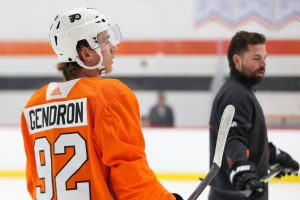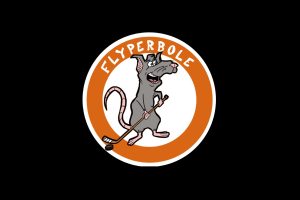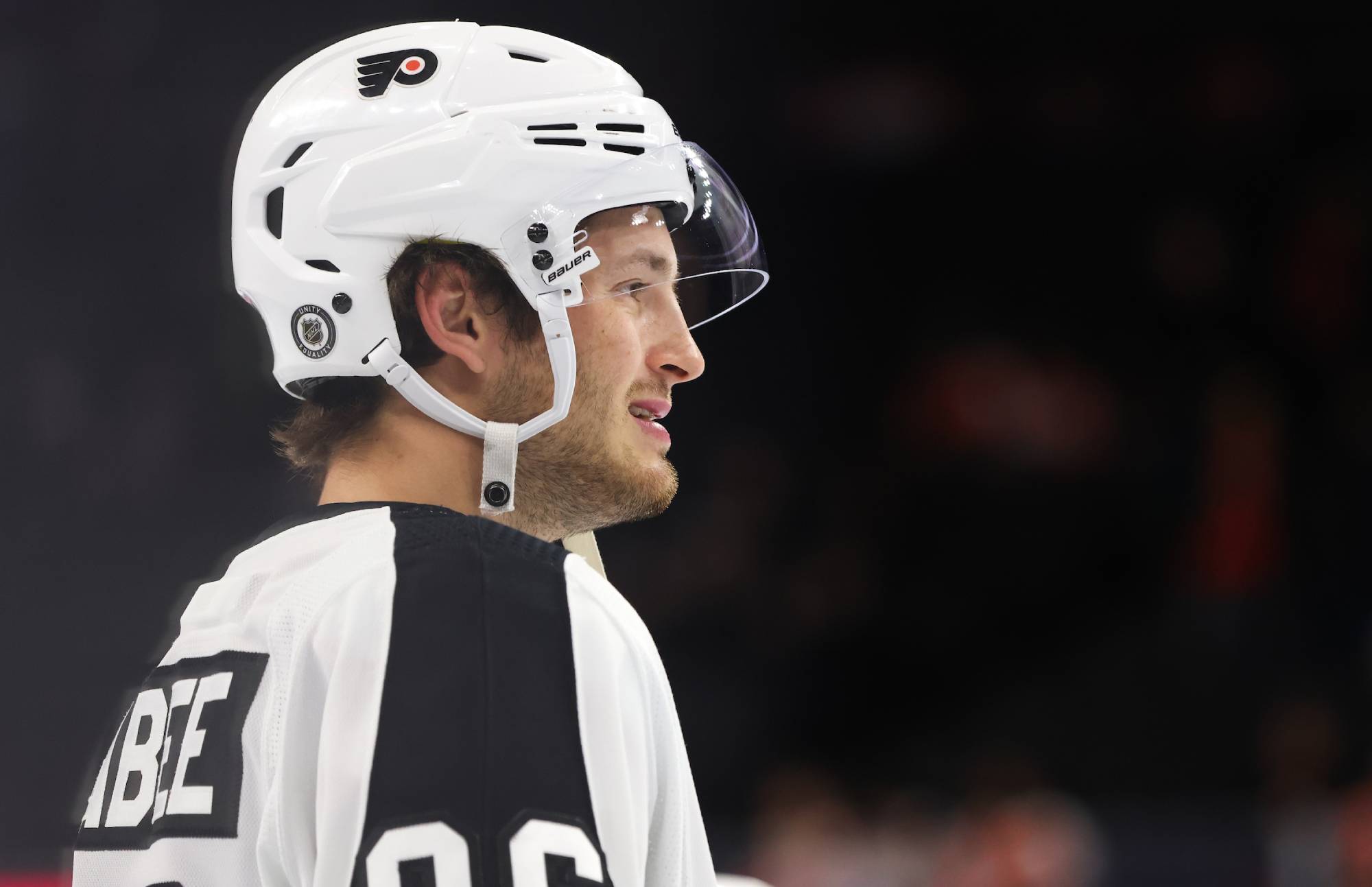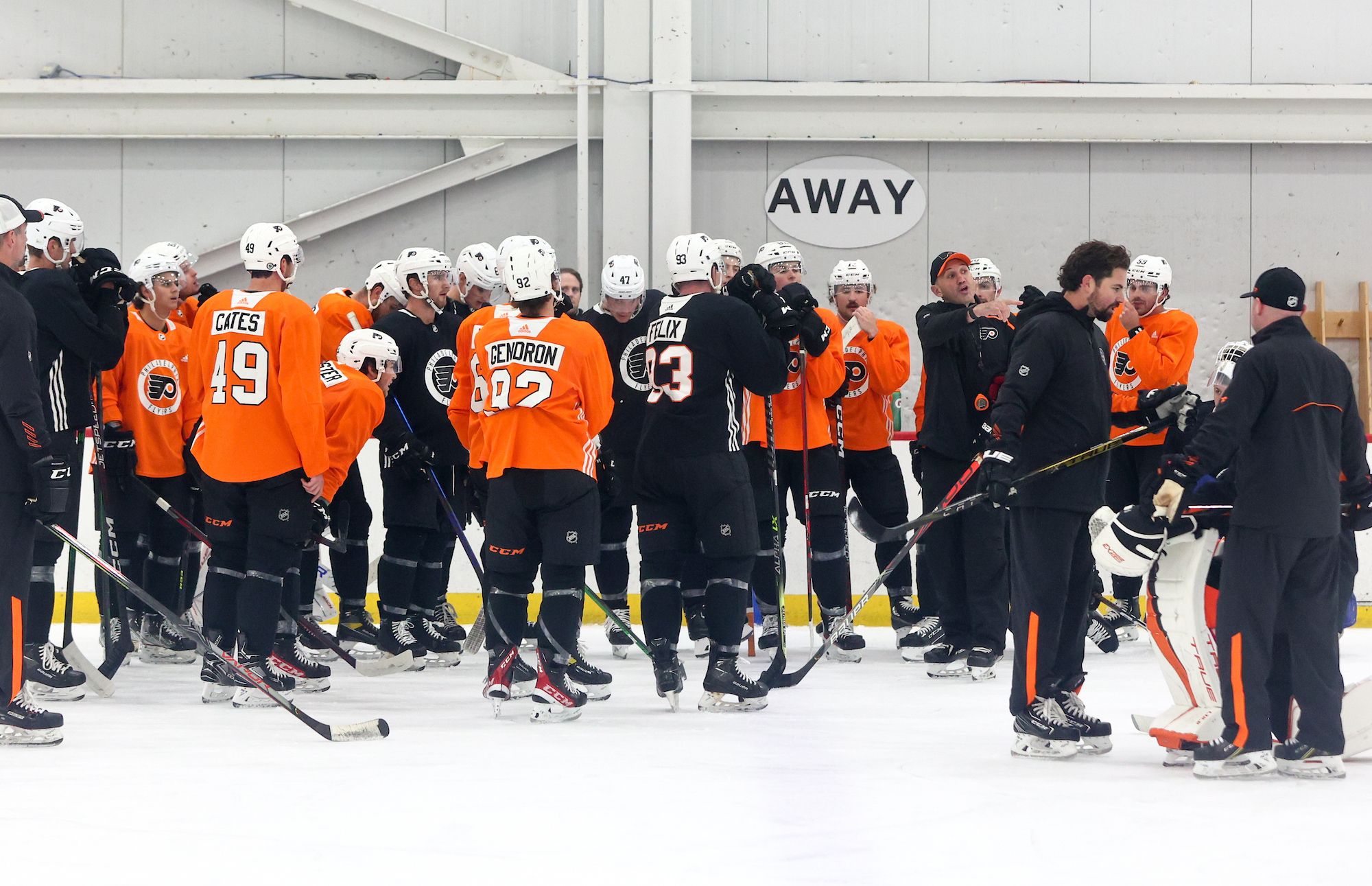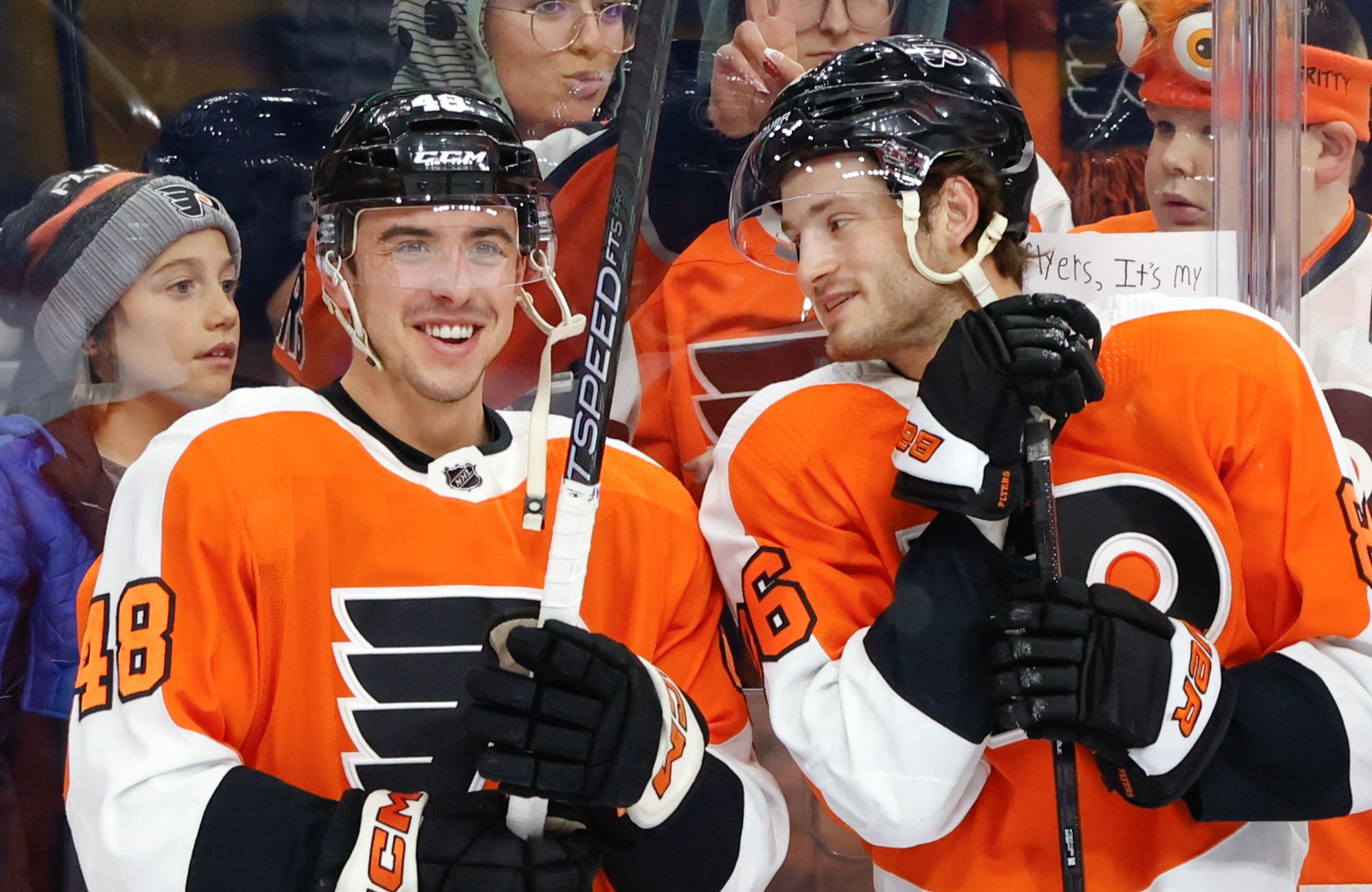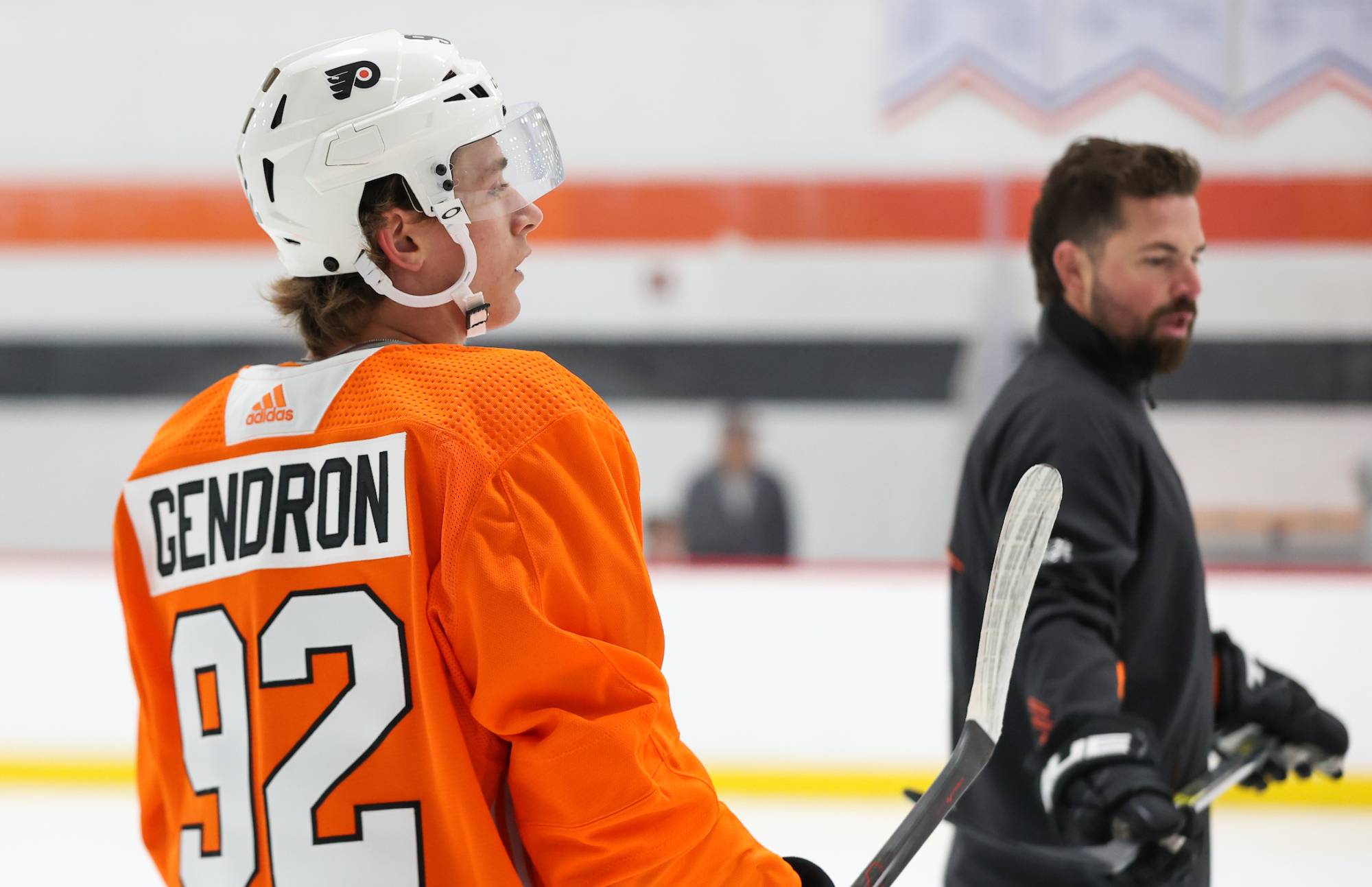Morning Observations is a feature where we break down the previous night’s game with an analytical eye.
#1: Flyers generated shots and chances, couldn’t finish
After such a frustrating loss, it can be difficult to go back and look at it with a positive lens. But if you listened to the Flyers’ players in their locker room after the game (Claude Giroux especially), there wasn’t much in the way of despondency. The captain certainly wasn’t happy — there was an obvious undercurrent of anger in his voice — but he remained steadfast in his belief that his teammates did lots of things right, and for some reason just were not getting rewarded.
Giroux isn’t really wrong. The Flyers outshot the Sabres 40-27, and won all of the key 5-on-5 shot volume battles. They dominated in raw volume, posting a 60.13% score-adjusted Corsi, and held a slight edge in xG during that situation, 1.86-1.73. Philadelphia posted even larger advantages after accounting for all situations — 64.29% in Corsi and 56.78% in xG. In terms of the overarching process, the Flyers didn’t do much wrong.
But despite all of that shot creation, the Flyers could manage just one goal on the night. That was due to a combination of a strong game from Buffalo backup netminder Anders Nilsson and an inability to either beat the goaltender with the first shot, or fight to the front of the net to collect the rebounds that Nilsson repeatedly allowed all game long. Even though the goalie absolutely had a strong game, the opportunities were there for Philadelphia. The Flyers simply couldn’t take advantage.
#2: Still, Hakstol deserves criticism for MacDonald
The above analysis focuses mostly on the Flyers’ inability to score more than one goal last night despite peppering the Buffalo net with shot attempts. That’s part of the story, but it fails to address the question of goal prevention. After all, Philadelphia allowed three goals in the second period, a deficit that they would never come close to overcoming. Those goals weren’t a result of bad luck, or especially poor goaltending, or even due to getting thoroughly outplayed. No, the goal prevention issues that the Flyers dealt with in the middle stanza can be primarily laid at the feet of two people: Andrew MacDonald for an absolutely awful performance, and Dave Hakstol for putting him a role where that poor play would prove this detrimental to his team.
Hakstol has made a number of shrewd moves recently. Following the return of Sean Couturier from injury, he’s cut the minutes of the Bellemare line dramatically (they received less than six minutes at 5v5 last night). The coach’s new third line of Brayden Schenn, Wayne Simmonds and Dale Weise also has been surprisingly effective, cycling well on the attack especially. But there remains one glaring issue in terms of lineup optimization, and that is the continued presence of Andrew MacDonald as a top-four defenseman alongside Ivan Provorov. Last night, MacDonald was on the ice for all three Sabres goals during the second period and was primarily at fault on two of them. And these weren’t isolated mistakes — from the start of the contest, MacDonald was a complete mess. His team low 41.38% score-adjusted Corsi (-29.45% relative to his teammates) last night speaks to this. You don’t end up rating that poorly just due to a few big mistakes.
But how big those mistakes were. On goal #1, MacDonald lost coverage on the low man in Buffalo’s power play formation, leaving Sam Reinhart more than enough time along the goal line to collect the puck and blast a shot by Steve Mason. Goal #2 was primarily on Mason for allowing a huge rebound and the forwards for a poor backcheck, so MacDonald gets a pass there. But then he’s right back on center stage for the third Buffalo goal, where he kicked off the entire sequence with an awful pass up the middle of the ice in the defensive zone that was picked off.
Right now, Hakstol’s only healthy defenseman currently in the press box is Nick Schultz, so it’s not fair to criticize the coach too much for the fact that MacDonald is still playing on a nightly basis. The bigger problem is twofold — MacDonald continues to see top-four minutes, and he remains paired with Ivan Provorov. The Provorov-MacDonald pairing has been a disaster in terms of driving play at 5v5 for weeks now (43.15% score-adjusted Corsi together) and have only appeared to be passable because their on-ice goal-based results have been solid. But last night was predictable, because that decent goal differential was never going to hold up considering how often the pair was getting buried in their own zone. Eventually, pucks were going to start going into the net, and it’s on Hakstol that the duo’s underlying performance was ignored, allowing for this debacle to eventually occur. If MacDonald has to be in the lineup, he should be in a sheltered role, getting the least minutes of any defenseman. And the second Mark Streit can return, MacDonald should either take up a permanent residence in the press box or at Lehigh Valley. That’s the hard truth.
NHL.com Report & Highlights | Corsica.Hockey Game Recap Page | HockeyStats.ca Recap | NaturalStatTrick Recap | HockeyViz.com | BSH Recap | Meltzer’s Musings
#3: Gostisbehere was stellar, and clearly is snakebit right now
While Andrew MacDonald was by a large margin the worst Flyers’ defenseman on the night, Shayne Gostisbehere was (by a nearly equal margin) the best one. Not only did Ghost finish with a strong 68.42% score-adjusted Corsi on the night, he also was the team’s best shot creator, putting seven on goal and racking up 11 total. He was dynamic all game long, constantly joining the rush, pinching to keep pucks alive on the cycle, and even activating down low with the puck to keep the Sabres off balance in coverage. It was a crime that Gostisbehere didn’t even earn a single point for this performance.
It hasn’t been a perfect season for Ghost, by any means. Now at the 41-game mark, the 23-year old defenseman has just four goals and 19 total points, on pace for less than 40 over a full schedule. But if Gostisbehere was granted a great deal of good fortune in his rookie season, the pendulum has swung the other way entirely this year. Despite driving far better shot attempt differentials (and more offense on the whole) in 2016-17 versus his rookie year, Ghost’s 5v5 scoring has fallen off a cliff. Some of that is on the player, as he could be doing a better job of getting shots through. But when an ultra-skilled, creative offensive defenseman has a lower 5-on-5 Points/60 than Brandon Manning, Radko Gudas and Nick Schultz, it just feels like an anomaly begging to be corrected in the season’s second half.
#4: Too many shots from the outside
If the Flyers have an issue in the offensive zone, it’s that their strategies are becoming all too predictable. Rather than look to pass the puck into the slot or set up shots via passes from behind the net, Philadelphia tends to fall back on point shots from defensemen as their primary way of generating offense, particularly when they are chasing a game. There’s some justification here — the Flyers do have a number of players such as Wayne Simmonds and Michael Raffl who thrive creating traffic in front and turning harmless shots from distance into dangerous chances. In addition, defensemen like Gostisbehere and Provorov do possess plus shots, so giving them extra opportunities to fire away isn’t a terrible call.
But there’s such a thing as too much. In the third period, Philadelphia sent 26 shots towards the Buffalo net at 5v5, but not one counted as a high-danger scoring chance. That’s because the dominant strategy late was to fire away from the point and hope for a deflection or a rebound. In a sense, you can argue that they didn’t “get the bounces,” but maybe a better approach would be a shot generation strategy that isn’t almost entirely dependent upon getting those bounces.
#5: Do the Flyers have a new top pair?
For the majority of December, the Ivan Provorov-Andrew MacDonald duo was used by Dave Hakstol as his top defensive pairing, both in terms of raw 5v5 minutes, and by the matchups they tended to receive. On a nightly basis, 9-47 was facing top line competition and was getting hard matched by Hakstol, an obvious show of faith. However, in recent games, Hakstol has turned more towards his preferred top pairing from the 2015-16 season, the duo of Michael Del Zotto and Radko Gudas.
Del Zotto and Gudas led the defense (and the team) in 5v5 ice time against the Sabres, just as they did in Columbus. In fact, in every game of 2017, one of Gudas or Del Zotto has ranked in the top-two in 5v5 ice time. What we’re seeing is a shift away from the Provorov-MacDonald pairing at the top of the depth chart, and it’s a justified one. The “new” top pair of MDZ and Gudas delivered a stellar 67.74% Corsi For percentage last night, and they proved last year that they have the ability to drive play nightly. It’s unfortunate that Provorov can’t be a part of the top pair considering his skills, but as long as he remains joined at the hip to MacDonald, anything that takes away minutes from the latter is a good thing for Philadelphia.
#6: Power play finally scored
The fact that the Flyers’ top power play unit did not score a goal on their first opportunity of the game last night had almost nothing to do with Philadelphia’s performance and everything to do with the play of Anders Nilsson. It was a shooting gallery on the Sabres goaltender at 5v4, as the top unit blasted six shots in less than two minutes of ice time, for a dominant Corsi For per 60 rate of 240 — double the shooting rates of some of the best power plays in hockey.
Their goal late in the game was during a 6-on-4 situation, so it was a little different than your standard power play opportunity. Still, it was a positive to see the unit (plus Ivan Provorov) rewarded for their hard work early on, at least in terms of efficiency rating if not actual impact on the game. Some have criticized the PP for going through a bit of a rough stretch in terms of goals recently, and that’s fair to a degree. After all, it needs to light the lamp for Philadelphia to overcome its relative mediocrity at 5v5, which was a task it failed early in this game. But the process is sound — they’re still peppering goalies with shots, and creating quality chances as well. The floodgates are about to open up.
#7: Old worries return regarding new Giroux line
When Matt Read was added to the top line prior to the weekend, the primary concern was that his strengths as a play-driver at 5v5 would be overshadowed by his diminishing offensive game. It was a fair concern. After all, a line with Read, Michael Raffl and Claude Giroux probably should be expected to outscore the opposition over a large sample due to their likely territorial edge, but the “top” line is supposed to score goals, and Matt Read’s days as a 20-goal scoring sniper appear long gone. In their first game together, however, the trio did score a 5v5 goal, temporarily quieting the worries.
However, we’re now looking at two straight games that saw the Raffl-Giroux-Read line drive play but fail to light the lamp. The two wingers finished with stellar Corsi For percentages (67.25% for Read, 66.63% for Raffl) and the scoring chances were plentiful as well, just as they were in Columbus. But the goals were yet again nowhere to be found. To my eyes, it seems like the line is doing everything right except scoring. But I would understand if Hakstol, dealing with an entire lineup that is slumping, does not have the patience to wait for the results to match the underlying metrics.
#8: Bellemare line continues its descent in stature
It seems like just yesterday that Pierre-Edouard Bellemare and company were joined at the hip to Connor McDavid, functioning as the tough minutes shutdown line against maybe the best player in the world. But with the return of Sean Couturier, the Bellemare line has not merely been relegated to fourth line duties, but to true 5-on-5 afterthought. Sure, they still have received some shifts at key moments, including an odd appearance in the late stages of a 1-0 game in Columbus. For the most part, however, the line has been on the bench. In seven out of the last eight games, Bellemare has received less than 10 minutes of 5-on-5 ice time, and last night was the least demanding yet, as the Flyers’ 4C played in just 5:31 minutes.
Surely, this was partially due to the fact that the Flyers were trying to overcome a major deficit in the third period, and a line with Bellemare, Chris VandeVelde and Roman Lyubimov is not the one best suited for such a situation. But they were stapled to the bench even early on in this game. I think the decrease in role is primarily due to the fact that Hakstol currently has three “scoring” lines that he rightfully trusts, which creates less of a need for him to fall back on the Bellemare unit. It’s a positive trend, and one that hopefully holds.
#9: Jakub Voracek is struggling a bit
Despite Wayne Simmonds earning the Flyers’ one guaranteed spot in the All Star Game, I’d argue that Jakub Voracek has been the team’s best forward so far this year. Not only does he lead the team in scoring, Voracek also has taken a more active role on the PP this year, which has resulted in a more dangerous all-around unit. However, just because he’s having a great season, that does not mean he’s immune to criticism. Over the past eight games, Voracek has only scored in two of them, and has a negative Corsi relative to his teammates in six (not coincidentally, the games that he failed to score in).
He’s still showing flashes of brilliance, so I’m not especially worried that Jake is dealing with an injury or seeing his game regress. He just seems a bit off from a timing standpoint on too many shifts, resulting in failed entries into the offensive zone or uncharacteristic turnovers. My guess is that as the Konecny-Couturier-Voracek line regains its past chemistry, he’ll start to deliver better results at 5v5, but this is something to keep an eye on.
#10: Flyers can’t be giving away points against bad teams
Philadelphia has a tough weekend ahead, as they’ll face back-to-back games against the best play-driving team in the NHL (Boston) and then one of the most talented in the NHL (Washington). That’s why this midweek stretch against Buffalo and Vancouver felt so important. It’s not that the Flyers can’t beat the Bruins or Caps, but when you have two games against non-contenders right before that gauntlet, it’s an easy way to bank points in case the weekend goes bad.
Instead, the Flyers couldn’t even steal one point from the lowly Sabres. Even if they can defeat the Canucks (as they should), they’re now in a position where keeping pace with the clubs who are catching up to the Flyers in games played might require a sweep of the weekend back-to-back. And aside from a brief respite next weekend against the Devils and Islanders, things get tough again very quickly, with the Rangers, Kings, Canadiens, Blues and Sharks coming in the near future. Games against teams like Buffalo should be easy wins, not slogs like last night was.



